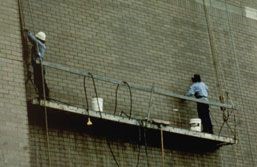Two-Point Scaffolds
Two-point adjustable suspension scaffolds, also known as swing-stage scaffolds, are perhaps the most common type of suspended scaffold. Hung by ropes or cables connected to stirrups at each end of the platform, they are typically used by window washers on skyscrapers, but play a prominent role in high-rise construction as well.

Note: Except where indicated, the same basic scaffold requirements that appear in this module also apply to single-point adjustable, multi-point adjustable, catenary, interior hung, needle-beam, multi-level, and float (ship) scaffolds which will be covered in the next module.
Inspecting the Anchorage
The safe use of a suspended scaffold begins with secure anchorage. The weight of the scaffold and its occupants should be supported by both the structure to which it is attached and by each of the scaffold components that make up the anchorage system.
We will discuss each of the scaffold components below.
- tiebacks
- counterweights
- direct connections
Note: Except where indicated, these requirements for anchorages also apply to multi-level, single-point adjustable, multi-point adjustable, interior hung, needle-beam, catenary, and float (ship) scaffolds.
Knowledge Check Choose the best answer for the question.
5-2. Two-point adjustable scaffolds are typically used by _____.
You forgot to answer the question!
